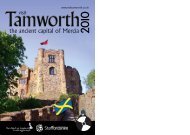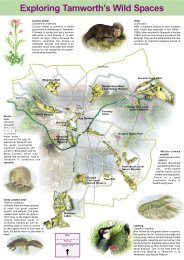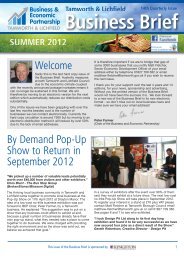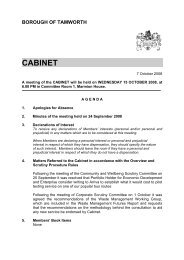Conservation Management Plan - Tamworth Borough Council
Conservation Management Plan - Tamworth Borough Council
Conservation Management Plan - Tamworth Borough Council
Create successful ePaper yourself
Turn your PDF publications into a flip-book with our unique Google optimized e-Paper software.
1.3 Assessment of significance<br />
1.3.1 The significance of the Norman Castle<br />
How typical is <strong>Tamworth</strong> Castle of this ubiquitous class of monument? Norman castles were a new feature in the<br />
urban setting, representing a type of private fortification, that stood in marked contrast to the communal defensive<br />
tradition of the late Saxon period. What effect did this new high status presence have on the urban community at<br />
<strong>Tamworth</strong>?<br />
Castle building in medieval England was a predominantly rural phenomenon. For complex social and political<br />
reasons the medieval elite tended to build their defensible residences in the countryside rather than in urban<br />
settings (Higham and Saunders 1997: 122). In England, those castles built in urban settlements, were predominantly<br />
royal in origin. The Lords of <strong>Tamworth</strong> Castle had very close links with royalty, initially as the Chief Royal Steward<br />
and subsequently a succession of Royal Champions.<br />
Castles built within the urban centres of late Anglo-Saxon England form a coherent group in terms of their settings,<br />
initial functions and the date of their foundations. These sites, including some of the most imposing mottes and<br />
largest ringworks in Britain, were raised with very few exceptions, in the unique socio-political context of the<br />
immediate post-Conquest years (c.1066-80), and the majority , like <strong>Tamworth</strong>, are sited in Saxon burhs (Armitage<br />
1912:94-6; Drage 1987: 117). Almost 50% of all castles documented positively before 1100 have urban settings.<br />
In a very short space of time, the majority of towns acting as major centres of regional administration in the first<br />
half of the 11th century had castles imposed on them. Most of these towns had royal connections (as did <strong>Tamworth</strong>)<br />
Robert le Despencer was the King’s main steward, hence the title ‘le Despencer’; many contained mints (as did<br />
<strong>Tamworth</strong>) and collectively they represented the machinery for political control.<br />
With the towns of England on the eve of Conquest containing an estimated 5-7 % of the population, William’s policy<br />
suppressed population centres and wealthy and powerful enclaves with the potential to challenge royal authority<br />
(Hinton 1990:115) The original Stafford castle was built in 1070, as opposed to the baronial castle, which was built<br />
some distance from the town (Soden 2007). Most castles (like the second Stafford castle) were built to further the<br />
aims of individual lords rather than as part of a national strategy. Urban castles were the notable exception.<br />
The early castles, constructed under the express orders of William as tools of military conquest, and the most<br />
‘Norman’, are paradoxically similar in concept (if not appearance) to the late Saxon burhs of Aethelfled. The<br />
Aethelfledan burhs like <strong>Tamworth</strong>, were primarily fortified enclosures for the containment of garrisons, built to<br />
dominate centres and control communication routes. This contrasts with the earlier burhs built by her father Alfred<br />
in Wessex, which were planned to enclose the population and centralize the means of production. The defensive<br />
circuit around the town of <strong>Tamworth</strong> is very similar, both in form and function, to what survives of the <strong>Tamworth</strong><br />
Castle bailey defences.<br />
In the years immediately following the conquest, urban castles were not seigneurial residences in any real sense.<br />
Built under royal control these castles were nearly always entrusted to appointed officials such as castellans,<br />
stewards (Robert le Despencer) or sheriffs (Robert Marmion, Philip Marmion). It is only later that they emerge as the<br />
seats of feudal baronies.<br />
The castle was a potent symbol of the newly established Norman regime and a reminder to the indigenous<br />
population of who held power in the new order. At the White Tower in London, the strongest, most impressive and<br />
best maintained defences of the White Tower, built around 1078, faced towards rather than away from the Saxon<br />
town and its resentful citizens (Vince 1990: 39).<br />
At <strong>Tamworth</strong> the principal point of access faces the town, and the 13 th gatehouse may be on or close to the site of<br />
Norman entrance. Invariably in an urban setting the castle gatehouse faces into the town. The exceptional height<br />
of the motte at <strong>Tamworth</strong>, was necessary to create an elevated structure that loomed over the town and the former<br />
palace/monastery enclosure on the higher ground to the north. The psychological impact of the massive motte,<br />
stone shell keep with its tall tower (and display window) and massive herringbone masonry wing wall, would have<br />
been pronounced, as it was a conspicuously elevated structure, at a time of low rise timber buildings.<br />
<strong>Tamworth</strong> Castle <strong>Conservation</strong> <strong>Management</strong> <strong>Plan</strong> www.marionblockley.co.uk<br />
Part 1<br />
47







